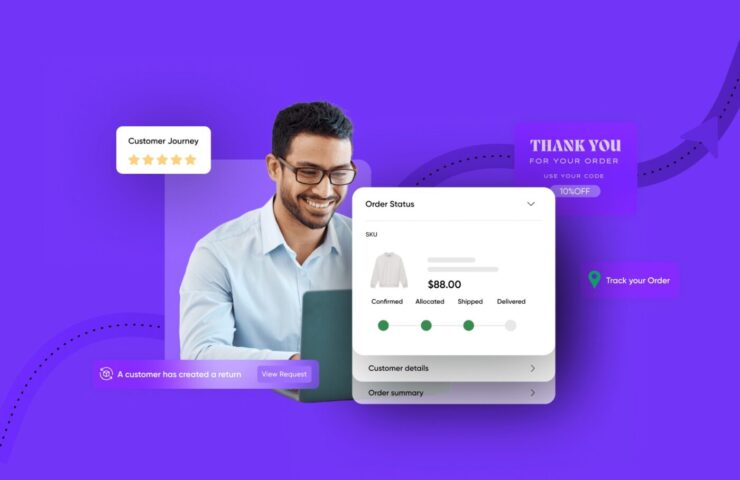Post-purchase experience represents everything that happens after a customer clicks “buy.” It includes delivery updates, customer service interactions, returns, and brand follow-ups.
Many companies focus heavily on acquisition, chasing new buyers, while neglecting those who already trusted them. Yet retaining existing customers is far more profitable.
Studies consistently show that increasing retention by just a few percentage points can significantly raise profits.
Enhancing the post-purchase phase transforms routine operational tasks into meaningful brand-building opportunities.
A well-designed experience builds sustainability by reducing churn, encouraging repeat purchases, and strengthening loyalty over time.
Emotional Drivers of Loyalty

Customer loyalty begins right after the purchase.
Emotions dictate how buyers interpret their experience, influencing repeat behavior and long-term attachment.
Post-purchase interactions have the power to either strengthen confidence or generate regret.
Brands that recognize and manage these emotions strategically can turn one-time customers into lifelong supporters.
The Role of Emotions in Post-Purchase Experience
Emotions influence nearly every purchasing decision. After buying, feelings such as anticipation, excitement, or even regret can shape how a customer views a brand.
Positive reinforcement, transparency, and reassurance ease post-purchase anxiety, allowing customers to feel secure in their choice.
Trust grows when brands communicate clearly about delivery, product quality, and support availability.
Transparency plays a major role in mitigating fear or uncertainty. Brands that show accountability during post-purchase interactions demonstrate reliability.
Emotional safety fosters trust, which ultimately becomes the foundation for long-term loyalty.
Turning Emotional Moments into Loyalty
Proactive communication can transform nervous anticipation into satisfaction. Sending clear updates on orders and follow-up messages helps customers feel valued.
Storytelling and personalization amplify emotional connections, reminding customers why they chose the brand in the first place.
Brands that connect emotionally convert ordinary transactions into lasting relationships.
Post-purchase storytelling, such as featuring real customer stories or sustainable values, builds attachment and advocacy.
Every reassuring touchpoint strengthens emotional engagement and reinforces brand commitment.
Technology as a Loyalty Enabler

Modern loyalty depends on technology that unites operations, communication, and data into one cohesive system.
Many brands struggle to deliver a consistent post-purchase experience because their technology stacks operate in isolation.
Integrating these systems transforms fragmented processes into efficient, customer-centered operations.
Technology also enables automation, speed, and personalization at scale, helping brands maintain loyalty without overburdening human teams.
The Problem of Fragmentation
Many businesses struggle because customer data, logistics, and support systems operate separately.
Fragmentation causes:
- Delays
- Inconsistent communication
- Frustration
Customers lose confidence when information about their orders or issues is scattered across departments.
Integrated systems prevent these breakdowns by ensuring that every interaction feels connected and seamless.
Trust erodes quickly when messages conflict or support lacks visibility into a customer’s history.
Integration Solutions
Unified technology creates the backbone of an excellent post-purchase strategy.
Integrating order management systems (OMS), CRM tools, support platforms, and logistics data ensures smooth, real-time communication.
Each department works in harmony, resulting in faster responses and fewer errors.
When systems align, employees can access customer history and order status instantly.
A well-integrated post-purchase platform brings cohesion and consistency, transforming fragmented operations into customer-focused efficiency.
AI and Automation
AI tools and automation enhance personalization and speed.
Automated shipping updates, smart chatbots, and predictive product recommendations keep customers informed and engaged.
These technologies free human teams to focus on more meaningful interactions.
AI-powered personalization creates relevant suggestions based on purchase behavior, improving satisfaction and boosting repeat sales.
Automation ensures consistency, turning every stage of the post-purchase process into an effortless experience.
Key Components of an Effective Post-Purchase Strategy

Building loyalty depends on well-designed post-purchase systems that make customers feel informed, supported, and valued.
A successful strategy focuses on:
- Transparency
- Flexibility
- Personalization
- Community engagement
When executed effectively, these components create consistent satisfaction and motivate customers to return.
Transparent Delivery and Real-Time Tracking
Customers expect precision and visibility once they place an order. Proactive updates and accurate tracking reassure them that everything is on schedule.
Disjointed tracking systems or vague delivery estimates can quickly erode trust.
Clear communication throughout delivery reduces anxiety and increases satisfaction.
As expectations rise, accurate delivery windows and reliable tracking are essential for maintaining loyalty.
Transparency shows professionalism and respect for customers’ time.
Seamless and Supportive Returns Process
Returns represent an opportunity to build trust rather than a financial burden.
A smooth process demonstrates care and reliability, encouraging repeat purchases.
Data shows that 84% of shoppers refuse to return after a poor experience, proving how crucial this element is.
Quick refunds, instant credits, and flexible exchanges enhance satisfaction.
When customers feel confident about post-purchase support, hesitation before buying decreases.
A positive returns process can turn potential disappointment into loyalty, positioning a brand as customer-focused and trustworthy.
Personalized and Timely Communication
Personalization ensures customers feel remembered and valued.
Sending tailored emails or SMS messages for order confirmations, shipping updates, and follow-up surveys adds relevance.
Each touchpoint reduces uncertainty and prevents unnecessary WISMO (Where Is My Order) inquiries.
Timely communication also builds reliability. When customers know they can expect updates, trust grows naturally.
Personalized outreach reflects an investment in customer relationships rather than automated processes alone.
Community Building and Social Engagement

Building communities around a brand creates an environment of shared enthusiasm.
Encouraging customers to share experiences, provide feedback, and interact with each other turns engagement into advocacy.
Social media groups and loyalty programs extend the post-purchase phase into a collective experience.
Engaged customers become storytellers, promoting the brand voluntarily.
Positive interactions strengthen emotional bonds and provide valuable insights into evolving customer expectations.
Communities also serve as informal support channels, creating authentic trust and satisfaction.
The Bottom Line
Post-purchase engagement defines modern brand success. Customers judge reliability based on how they are treated after paying. Companies that invest in personalization, technology, and proactive communication create loyal advocates instead of one-time buyers.
Sustainable brands grow through long-term relationships, not just conversions. A thoughtful approach to the post-purchase experience transforms every interaction into an opportunity to build trust, loyalty, and continuous growth.

